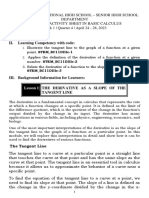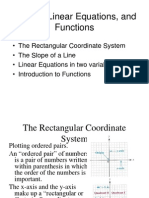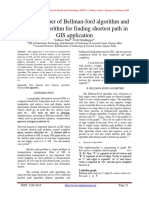Chapter 3-functions and graphs
Uploaded by
meiertalitaChapter 3-functions and graphs
Uploaded by
meiertalitalOMoARcPSD|42171390
3. Functions and Inverses
A. Revision from grade 11
The Straight Line Graph
→ y = mx + c
Δ𝑦 𝑦2 − 𝑦1
m = gradient or 𝑜𝑟 𝑚 =
Δ𝑥 𝑥2 − 𝑥1
c = is the y-intercept
The quadratic function / parabola will be dealt with in section E.
The hyperbola
𝑘
→ 𝑦= +𝑞
𝑥−𝑝
k = the constant; if k is negative the graph is in the 2nd and 4th
quadrants, and if k is positive the graph falls in the 1st and 3rd
quadrants.
p = is the shift left (x + p) or right ( x – p) of the graph.
x = p is the horizontal axis
q = shift up (+ q) or down (-q) of the graph.
y = q is the vertical asymptote of the graph.
There are two lines of symmetry for the hyperbola →
The gradient is always + 1 or – 1.
To find c (y = mx + c) substitute the point of intersection of the two
asymptotes.
3
Eg. Given that 𝑓(𝑥 ) = + 3 find the equations of the two lines of
𝑥−2
symmetry. Gradient / m = ± 1; the point of intersection is (2; 3).
y = - 1x + c or y = 1x + c
3 = -1 (2) + c 3 = 1(2) + c
c=5 c=1
y = -x + 5 or y=x+1
Downloaded by Talita Meier (meiertalita@gmail.com)
lOMoARcPSD|42171390
Activity 3.1
1. Below are two graphs, f(x) which is a straight line and g(x) which is a
hyperbola. They intersect at the point A (2;8).
y
a) Determine the equation of the straight line f(x).
b) Determine the equation of the hyperbola given that the x-
asymptote is at 1 and the y-asymptote is at -2.
c) Find the other point of intersection of the straight line graph
and the hyperbola.
d) Determine the equations for the lines of symmetry for the
hyperbola.
Downloaded by Talita Meier (meiertalita@gmail.com)
lOMoARcPSD|42171390
2. Given the equation of the graph f(x) = 2x – 3 and that the second
function g(x) is a hyperbola. y
a) Give the equations for the two asymptotes.
b) Determine the equation of g(x).
c) Give the two coordinates where the graphs intersect.
d) Determine the two equations of symmetry for the hyperbola.
e) For which values of x is f(x) > g(x).
f) Give the equation of h(x) if g(x) is shifted two units to the right
and three units down.
g) Give the equation of j(x) if f(x) is reflected in the x-axis.
𝑎
3. The formula f(x) = + 3 is given for the graph of the hyperbola
𝑥+2
where the y-intercept is the point (0; 2).
a) Find a.
b) Determine the equations of symmetry for f(x).
c) Give the x-asymptote of f(x).
d) Give the equation of g(x) if g(x) = f(x-3) – 7.
e) Give the equation of h(x) which is the graph of f(x) reflected
about the x-axis.
Downloaded by Talita Meier (meiertalita@gmail.com)
lOMoARcPSD|42171390
B. Functions
Definition: A function occurs when for every value in a given set, there is
only one value in a second set. That is, for every x-value in the
domain (set of input values), there is only one corresponding y-value
in the range (set of output values).
One-to-one functions: For every x-value, there is only one
corresponding y-value.
Many-to-one function: There is more than one x-value mapping
onto a single y-value.
One-to-many function: There is a single x-value mapping onto
more than one y-value (this is not a true
function)
To test for a function you can do either a vertical or horizontal line test if
you are using a graph (you can do this by placing your ruler vertically on
the page and sliding it across the graph → if the ruler touches the graph
more than once in the same place the graph is not a function), or you
could generate a table of values using the equation.
Example:
Find out if the function given below is a one-to-one function. That means
that no x- or y-value is repeated. Use a table to answer this question.
𝑓 (𝑥 ) = 𝑥 2 − 1
x -3 -2 -1 0 1 2 3
y 8 3 0 -1 0 3 8
Therefore this is a many-to-one function because there are two y-values
for every x-value
You can also do this on your Sharp EL-W535HT by pressing .
Now enter the function by pressing
Your screen will now say X_start and X_step. Enter where you would like to start from for
example -3 and press and the leave the step as 1 so just press again.
Now check whether there are any repeating values and determine whether your graph is a
C. Symmetry function.
Downloaded by Talita Meier (meiertalita@gmail.com)
lOMoARcPSD|42171390
To find the reflection of a given point (p;q) about the y-axis, make ‘p’
negative → (p; q) reflected about x = 0 (y-axis) → (-p; q)
To find the reflection of a given point (p ; q) about the x-axis, make
‘q’ negative → (p; q) reflected about y = 0 (x-axis) → (p; -q)
To find the reflection of a given point e.g. (p; q) about the line
y = x, switch the co-ordinate values around, i.e. (q ; p)
(More of this topic will be covered in paper 2 – Transformations section)
D. Inverse Functions
To find the inverse of a function, we switch the x and y in the equation
and then solve for y again.
The original domain now becomes the range, and the original range now
becomes the domain.
The inverse can always be found for a one-to-one function.
The graph of the inverse function is reflected about the line, y = x, since
the x and y values have been switched. The line y = x is the line of
symmetry for a graph and its inverse.
The inverse can only be found for a many-to-one function if the values of
x are restricted (because the inverse graph becomes a one-to-many graph
which is not a function), therefore enabling the resultant function to be
the inverse.
Example:
Find the inverse of 𝑓(𝑥 ) = 𝑥 2 − 1.
Switch the x and y values.
𝑓 (𝑦) = 𝑦 2 − 1
∴ 𝑥 + 1 = 𝑦2 ,
Solve for y.
∴ 𝑥 + 1 = 𝑦2
∴ 𝑦 = √𝑥 + 1 = 𝑓 −1
Downloaded by Talita Meier (meiertalita@gmail.com)
lOMoARcPSD|42171390
The following keys on the EL-W535HT can be used for functions and
inverses:
For squaring values
For applying any exponent to a given base
For square rooting a value
For cubing a given value
For entering a fraction
For entering a mixed fraction
Activity 3.2
1. Given the following functions, use the Table Mode function on the
EL-W535HT to generate a table, and explain whether these functions
are one-to-one or many-to-one/one-to-many.
a) 𝑔(𝑥 ) = 𝑥 + 3 b) 𝑝(𝑥 ) = 𝑥 3
c) ℎ(𝑥 ) = 𝑥 2 + 𝑥 − 6 d) 𝑘(𝑥 ) = 𝑥 −1
e) 𝑠(𝑥 ) = √𝑥
2. For each of the following functions, find the inverse.
a) 𝑔(𝑥 ) = 𝑥 2 + 7 b) 𝑝(𝑥 ) = 𝑥 3 + 1
c) 𝑠(𝑥 ) = √𝑥 3
3. Write down the domain and range for each of the above equations,
and their inverses, so that they are functions.
Downloaded by Talita Meier (meiertalita@gmail.com)
lOMoARcPSD|42171390
E. Quadratic Functions
There are three formulae that you can use to find a quadratic function:
y = ax2 +bx + c → this is the standard equation. (In order to find this
equation you are usually given two points and you have to
substitute and solve for a, b, and c)
y = a(x – p)2 + q → this equation can be used to find the turning
point of the graph. p is your x-value turning point and q is your y-
value turning point (in order to find this equation you complete the
square) – often this form of the equation is given to you and you
need to find the other equation (ax2 + bx + c) by multiplying out.
y = a(x – x1)(x – x2) where x1 and x2 are your x-intercepts.
To calculate the x-intercepts: remember to make y = 0, and solve for x. If
the values cannot be found by factorising the trinomial, use the quadratic
−𝑏±√𝑏2 −4𝑎𝑐
formula: 𝑥 =
2𝑎
If you are having problems factorising remember that your SHARP EL-W535HT can help you.
Go to table mode. Once there put the equation in as a function.
Start at 1 by pressing and then . Press again so that your step
remains 1. Look in the ANS column for 0 (the x will then be one of your factors).
Remember that when x is positive in the table it is negative in your bracket. For example if
x = 7 and ANS = 0 then your factor is (x – 7).
Once you have this factor you can go back to normal mode. Simply divide the “c” value to find
the other factor. Put the number (or “a” value) that was in front of the x2 in the bracket that
has the second factor.
Remember to think about your signs…
To calculate the y-intercept: make x = 0.
Downloaded by Talita Meier (meiertalita@gmail.com)
lOMoARcPSD|42171390
To find the axis of symmetry/turning point:
𝑏
Axis of symmetry: −
2𝑎
Turning point (maximum or minimum point): Substitute the value of
𝑏
− into the original equation.
2𝑎
You can also find the turning point by completing the square or changing
the formula into the form of y = a(x – p)2 + q where (p;q) is your turning
point.
The domain is: 𝑥 ∈ (−∞; ∞)
The range is either from a minimum value to infinity, or from negative
infinity to the maximum value. To find the minimum or maximum find
your y-turning point.
The shape of your graph is determined by “a” → if a is positive your graph
has a smiley-face shape ( )
If “a” is negative it will have a sad-face shape ( ). If “a” is positive you
will have a minimum y-value and if “a” is negative you will have a
maximum y-value.
If “a” is positive your function’s gradient will first decrease and then
increase. If “a” is negative your function’s gradient will first increase and
then decrease.
Steps for completing the square:
- Take out the value of ‘a’ as a common factor, i.e. the coefficient of
𝑥 2.
- Multiply the coefficient of the x-term by a half, and then square the
answer.
- Add this value to create a new trinomial, and then to compensate
for this adding on, subtract the same value from the whole number
given in the original equation.
Downloaded by Talita Meier (meiertalita@gmail.com)
lOMoARcPSD|42171390
- Write the new equation in the form: 𝑦 = 𝑎(𝑥 − 𝑝)2 + 𝑞
Use this equation to calculate the turning point. To find the x- and
y-intercepts, make y = 0 and x = 0 in the original equation. If the
x-values cannot be found through factorisation, use the quadratic
formula.
Example:
1
𝑓(𝑥 ) = 𝑥2 + 𝑥 − 1
2
1
Step 1: Take out the common factor of
2
1
𝑓(𝑥 ) = 𝑥2 + 𝑥 − 1
2
1
∴ 𝑓(𝑥 ) = (𝑥 2 + 2𝑥 ) − 1
2
Step 2: Take the coefficient of x (e.g. 2) and substitute it into the axis
𝑏
of symmetry formula − and square this value:
2𝑎
2 2
∴ (− ) =1
2(1)
Step 3: Add 1 to the bracket and write this as a square, and then
subtract 1 from the constant outside the bracket (remember
that you have a common factor of so you need to multiply the
1 you are subtracting by when you take it out of the brackets).
1 1
𝑓(𝑥 ) = (𝑥 2 + 2𝑥 + 1) − 1 −
2 2
1 3
∴ 𝑓 (𝑥 ) = (𝑥 + 1 )2 −
2 2
3
Step 4: The turning point is (−1; − )
2
Downloaded by Talita Meier (meiertalita@gmail.com)
lOMoARcPSD|42171390
Step 5: The x-intercepts: Put the original equation equal to 0.
1
𝑓(𝑥 ) = 𝑥 2 + 𝑥 − 1 (multiply by 2 to get rid of the fraction).
2
0 = 𝑥 2 + 2𝑥 − 2 This cannot be factorised into 2 brackets,
therefore the quadratic equation must be
used.
−𝑏±√𝑏2 −4𝑎𝑐
𝑥=
2𝑎
1
−1 ± √12 −4( )(−1)
2
∴𝑥= 1
2( )
2
∴ 𝑥 = −1 + √3 𝑜𝑟 𝑥 = −1 − √3
∴ 𝑥 = 0.73 𝑜𝑟 𝑥 = −2.73
Step 6: The y-intercept: Put x = 0.
Therefore the intercept is (0; -1)
Activity 3.3
For each of the following quadratic functions:
(i) Find the turning point
(ii) Find the x and y intercepts
(iii) Find the axis of symmetry
(iv) Write down the domain and range of f(x)
1 5
a) 𝑓(𝑥 ) = 3𝑥 2 − 𝑥 − 2 b) 𝑓(𝑥 ) = 𝑥2 − 𝑥 + 4
4 2
1
c) 𝑓(𝑥 ) = 2𝑥 2 + 7𝑥 + 6 d) 𝑓(𝑥 ) = 𝑥 2 + 2𝑥 − 6
2
Downloaded by Talita Meier (meiertalita@gmail.com)
lOMoARcPSD|42171390
Answers for Activities
Activity 3.1
1.
a) y = mx + c
y = mx + 2 (y-intercept)
-4 = m(-2) + 2
-6 = m(-2)
m=3
∴ 𝑦 = 3𝑥 + 2
𝑎
b) 𝑦= +𝑞
𝑥−𝑝
𝑎
= −2
2−1
𝑎
10 =
1
1
a = 10. ∴𝑦= −2
𝑥−1
1
c) y = 3x + 2 and 𝑦 = −2
𝑥−1
Solve simultaneously
1
𝑥+2= −2
𝑥−1
1
3𝑥 + 4 =
𝑥−1
2
3𝑥 − 3𝑥 + 4𝑥 − 4 = 10
3𝑥 2 + 𝑥 − 14 = 0
(x – 2)(3x + 7) = 0
3
𝑥 = 2 𝑜𝑟 𝑥 = −
y=8 ∴ 𝑦 = 3 (− ) + 2
3
=-5
d) y=±x+c (1; -2)
-2 = +1 (1) + c OR -2 = -1 (1) + c
c = -3 c = -1
∴𝑦 =𝑥−3 𝑜𝑟 𝑦 = −𝑥 − 1
Downloaded by Talita Meier (meiertalita@gmail.com)
lOMoARcPSD|42171390
2. a) x = -2 and y=1
𝑎
b) 𝑔(𝑥 ) = +𝑞
𝑥−𝑝
𝑎
2= +1
+2
𝑎
1=
2
2
a=2 ∴ 𝑔(𝑥 ) = +1
𝑥+2
2
c) y = 2x – 3 and y= +1
𝑥+2
2
2𝑥 − 3 = +1
𝑥+2
2
2𝑥 − 4 =
𝑥+2
2
2𝑥 − 4𝑥 + 4𝑥 − = 2
2𝑥 2 − 10 = 0
𝑥2 − = 0
𝑥2 =
𝑥 = ±√
∴ 𝑦 = +√ 2−3 or 𝑦 = −√ 2−3
= 1,47 = - 7,47
d) y=±x+c (-2; 1)
1 = +1 (-2) + c or 1 = -1 (-2) + c
c=3 c = -1
y=x+3 y = -x -1
2
e) ℎ(𝑥 ) = +1−3
𝑥−2+2
2
= −2
𝑥
f) j(x) = -y = 2x -3
= -2x + 3
Downloaded by Talita Meier (meiertalita@gmail.com)
lOMoARcPSD|42171390
𝑎
3. a) 𝑓(𝑥 ) = +3
𝑥+2
𝑎
2= +3
+2
𝑎
−1 =
2
a = -2
b) y=±x+c (-2; 3)
3 = + 1(-2) + c OR 3 = - 1(-2) + c
c=5 c=1
y=x+5 y = -x + 1
c) x = -2
−2
d) 𝑔(𝑥 ) = +3−7
𝑥+2−3
−2
= −4
𝑥−1
−2
e) ℎ(𝑥 ) = −𝑦 = +3
𝑥+2
2
= −3
𝑥+2
Activity 3.2
1. a)
X -5 -4 -3 -2 -1 0 1 2 3 4 5
Y -2 -1 0 1 2 3 4 5 6 7 8
No x- or y-values are repeated, therefore this is a one-to-one function.
b)
X -5 -4 -3 -2 -1 0 1 2 3 4 5
Y -125 -64 -27 -8 -1 0 1 8 27 64 125
No x- or y-values have been repeated, therefore this is a one-to-one
function.
Downloaded by Talita Meier (meiertalita@gmail.com)
lOMoARcPSD|42171390
c)
X -5 -4 -3 -2 -1 0 1 2 3 4 5
Y 14 6 0 -4 -6 -6 -4 0 6 14 24
Values have been repeated, therefore this is a many-to-one function.
d)
X -5 -4 -3 -2 -1 0 1 2 3 4 5
Y -0.2 -0.25 -0.33 -0.5 -1 und 1 0.5 0.33 0.25 0.2
No x- or y-values are repeated, therefore this is a one-to-one function.
e)
X -5 -4 -3 -2 -1 0 1 2 3 4 5
Y 0 1 1.4 1.7 2.2 2.3
No x- or y-values are repeated, therefore this is a one-to-one function.
2.
a) 𝑔(𝑥 ) = 𝑥 2 + 7 b) 𝑝(𝑥 ) = 𝑥 3 + 1
𝑦 = 𝑥2 + 7 𝑦 = 𝑥3 + 1
𝑥 = 𝑦2 + 7 𝑥 = 𝑦3 + 1
𝑥 − 7 = 𝑦2 𝑥 − 1 = 𝑦3
𝑦 = ± √𝑥 − 7 √𝑥 − 1 = 𝑦
c) 𝑠(𝑥 ) = √𝑥 3
𝑦 = √𝑥 3
𝑥 = √𝑦 3
𝑥 2 = 𝑦3
2
𝑦 = √𝑥 2 𝑜𝑟 𝑦 = 𝑥
Downloaded by Talita Meier (meiertalita@gmail.com)
lOMoARcPSD|42171390
3.
a) 𝑦 = ±√𝑥 − 7 This is not a one-to-one function therefore the
domain has to be restricted. Domain: 𝑥 ∈ [7; ∞),
Range: [0; ∞)
b) 𝑦 = √𝑥 − 1 This is a one-to-one function therefore there is
no need to restrict the domain in order to make it a function.
Domain: ∈ (−∞; ∞) , Range: (−∞; ∞)
c) 𝑦 = √𝑥 2 This is a one-to-one function therefore there is no
need to restrict the domain in order to make it a function.
Domain: ∈ (−∞; ∞) , Range: (−∞; ∞).
Activity 3.3
a) 𝑓(𝑥 ) = 3𝑥 2 − 𝑥 − 2
𝑏
(i) TP: x-value → −
2𝑎
1
= −
2(3)
1
=
6
y-value: substitute x-value into the equation and solve for y:
1 2 1 1
𝑦 = 3( ) − − 2 = −2
6 6 12
1 1
Therefore the turning point is ( ; −2 )
6 12
(ii) X-intercept, make y = 0:
0 = 3𝑥 2 − 𝑥 − 2
0 = (3𝑥 + 2)(𝑥 − 1)
2
Therefore x = 1 or 𝑥 = −
3
Y-intercept, make x = 0:
𝑓 (0) = 3(0)2 − 0 − 2, therefore y = -2
Downloaded by Talita Meier (meiertalita@gmail.com)
lOMoARcPSD|42171390
(iii) Axis of symmetry is the line which passes through the turning
point to divide the graph in half.
1
Therefore, 𝑥 =
6
1
(iv) Domain: 𝑥 ∈ (−∞; ∞) Range: 𝑦 ∈ [−2 ; ∞)
12
1 5
b) 𝑓(𝑥 ) = 𝑥2 − 𝑥+4
4 2
5
−(− )
(i) TP: x-value → 2
1 = . Substitute into the equation to find y.
2(4)
1 5 1 1
Therefore 𝑦 = ( )2 − ( ) + 4 = −2 . TP = ( ; −2 )
4 2 4 4
(ii) X-intercept, make y = 0:
1 5
Therefore: 0 = 𝑥 2 − 𝑥 + 4
4 2
0 = 𝑥 2 − 10𝑥 + 16
0 = (𝑥 − 2)(𝑥 − )
x = 2 or x = 8
Y-intercept, make x = 0:
1 5
Therefore: 𝑦 = (0)2 − (0) + 4 = 4.
4 2
(iii) Axis of symmetry is the x-value of the turning point:
Therefore x = 5
1
(iv) Domain: 𝑥 ∈ (−∞; ∞) Range: 𝑦 ∈ [−2 ; ∞)
4
c) 𝑓(𝑥 ) = 2𝑥 2 + 7𝑥 + 6
−
(i) TP: x-value = − . Substitute into the equation for the y-value.
2(2) 4
2 1 1
𝑦 = 2 (− ) + 7 (− ) + 6 = − Therefore: TP = (− ; − )
4 4 8 4 8
Downloaded by Talita Meier (meiertalita@gmail.com)
lOMoARcPSD|42171390
(ii) X-intercepts, make y = 0:
Therefore,0 = 2𝑥 2 + 7𝑥 + 6
0 = (2𝑥 + 3)(𝑥 + 2)
3
∴𝑥= − 𝑜𝑟 𝑥 = −2
2
y – intercept, make x = 0:
Therefore, 𝑦 = 2(0)2 + 7(0) + 6 = 6
(iii) The axis of symmetry is 𝑥 = −
4
1
(iv) Domain: 𝑥 ∈ (−∞; ∞) Range: 𝑦 ∈ [− ; ∞)
8
1
d) 𝑓 (𝑥 ) = 𝑥 2 + 2𝑥 − 6
2
(−2)
(i) TP: x-value 1 = −2. Substitute into the equation for the
2( )
2
1
y-value. Therefore 𝑦 = (−2)2 + 2(−2) − 6 = − .
2
The TP is (-2 ; -8)
(ii) X-intercept, make y = 0:
1 1
Therefore: 0 = 𝑥 2 + 2𝑥 − 6 (Multiply by 2 to get rid of )
2 2
2
0 = 𝑥 + 4𝑥 − 12
0 = (𝑥 + 6)(𝑥 − 2)
∴ 𝑥 = −6 𝑜𝑟 𝑥 = 2
Y-intercept, make x = 0:
1
Therefore: 𝑦 = (0)2 + 2(0) − 6 = −6
2
(iii) The axis of symmetry: x = -2
(iv) Domain: 𝑥 ∈ (−∞; ∞) Range: 𝑦 ∈ [− ; ∞)
Downloaded by Talita Meier (meiertalita@gmail.com)
You might also like
- SAT II Math Level 2 Subject Test Notes: Functions100% (2)SAT II Math Level 2 Subject Test Notes: Functions3 pages
- Inverse Functions Inverse Trigonometric FunctionsNo ratings yetInverse Functions Inverse Trigonometric Functions38 pages
- Level K: Equations of Quadratic FunctionsNo ratings yetLevel K: Equations of Quadratic Functions6 pages
- FUNCTIONS_6bf5bb85-965f-440e-a69d-f2d2869ed80eNo ratings yetFUNCTIONS_6bf5bb85-965f-440e-a69d-f2d2869ed80e40 pages
- polynomial and rational functions slidesNo ratings yetpolynomial and rational functions slides85 pages
- Q2 Finding The Equation of A Quadratic FunctionNo ratings yetQ2 Finding The Equation of A Quadratic Function21 pages
- General Mathematics: Quarter 1: Week 6 Learning Activity SheetNo ratings yetGeneral Mathematics: Quarter 1: Week 6 Learning Activity Sheet8 pages
- To Graph A Relation, We Need To Plot Each Given Ordered PairNo ratings yetTo Graph A Relation, We Need To Plot Each Given Ordered Pair11 pages
- 1. the Slope of the Tangent Line and Derivative of a FunctionNo ratings yet1. the Slope of the Tangent Line and Derivative of a Function15 pages
- polynomial and rational functions slidesNo ratings yetpolynomial and rational functions slides91 pages
- M1L1_The Foolproof Method_with Example 3 IllustrationsNo ratings yetM1L1_The Foolproof Method_with Example 3 Illustrations7 pages
- 1.8+Rational+Functions+and+Pascal%27s+Triangle+%28completed%29No ratings yet1.8+Rational+Functions+and+Pascal%27s+Triangle+%28completed%294 pages
- Training Course 9 Senior Functions and TrigonometryNo ratings yetTraining Course 9 Senior Functions and Trigonometry32 pages
- Graphs, Linear Equations, and FunctionsNo ratings yetGraphs, Linear Equations, and Functions46 pages
- GenMath_Q1_LAS6_Graphing-Exponential-FunctionsNo ratings yetGenMath_Q1_LAS6_Graphing-Exponential-Functions17 pages
- Relations and Functions - Activity ModuleNo ratings yetRelations and Functions - Activity Module4 pages
- Unit I Solution OF Equations AND Eigenvalue Problems: WWW - Vidyarthiplus.inNo ratings yetUnit I Solution OF Equations AND Eigenvalue Problems: WWW - Vidyarthiplus.in140 pages
- Maths Class Ix Half Yearly Exam Sample Paper 03100% (1)Maths Class Ix Half Yearly Exam Sample Paper 034 pages
- International Math Bowl Open Round Practice Test 1No ratings yetInternational Math Bowl Open Round Practice Test 14 pages
- Ministry of Education, Culture and Research of The Republic of MoldovaNo ratings yetMinistry of Education, Culture and Research of The Republic of Moldova6 pages
- Examiner's Report Principal Examiner Feedback: Pearson Edexcel International A Level in Pure Mathematics P2 (WMA12/01)No ratings yetExaminer's Report Principal Examiner Feedback: Pearson Edexcel International A Level in Pure Mathematics P2 (WMA12/01)10 pages
- Practice Questions Quadratic Equations Class XNo ratings yetPractice Questions Quadratic Equations Class X1 page
- A Primer in Econometric Theory: Vector SpacesNo ratings yetA Primer in Econometric Theory: Vector Spaces104 pages
- A Survey Paper of Bellman-Ford Algorithm and Dijkstra Algorithm For Finding Shortest Path in GIS ApplicationNo ratings yetA Survey Paper of Bellman-Ford Algorithm and Dijkstra Algorithm For Finding Shortest Path in GIS Application3 pages
- Matrix Operation Linear Programming: AlgorithmsNo ratings yetMatrix Operation Linear Programming: Algorithms28 pages
- A Study On Domination, Independent Domination and Irredundance in Fuzzy GraphNo ratings yetA Study On Domination, Independent Domination and Irredundance in Fuzzy Graph9 pages
- Floyd Warshall Algorithm: (All Pair Shortest Path)No ratings yetFloyd Warshall Algorithm: (All Pair Shortest Path)17 pages
- General Mathematics: Quarter 1: Week 6 Learning Activity SheetGeneral Mathematics: Quarter 1: Week 6 Learning Activity Sheet
- To Graph A Relation, We Need To Plot Each Given Ordered PairTo Graph A Relation, We Need To Plot Each Given Ordered Pair
- 1. the Slope of the Tangent Line and Derivative of a Function1. the Slope of the Tangent Line and Derivative of a Function
- M1L1_The Foolproof Method_with Example 3 IllustrationsM1L1_The Foolproof Method_with Example 3 Illustrations
- 1.8+Rational+Functions+and+Pascal%27s+Triangle+%28completed%291.8+Rational+Functions+and+Pascal%27s+Triangle+%28completed%29
- Training Course 9 Senior Functions and TrigonometryTraining Course 9 Senior Functions and Trigonometry
- A-level Maths Revision: Cheeky Revision ShortcutsFrom EverandA-level Maths Revision: Cheeky Revision Shortcuts
- Unit I Solution OF Equations AND Eigenvalue Problems: WWW - Vidyarthiplus.inUnit I Solution OF Equations AND Eigenvalue Problems: WWW - Vidyarthiplus.in
- International Math Bowl Open Round Practice Test 1International Math Bowl Open Round Practice Test 1
- Ministry of Education, Culture and Research of The Republic of MoldovaMinistry of Education, Culture and Research of The Republic of Moldova
- Examiner's Report Principal Examiner Feedback: Pearson Edexcel International A Level in Pure Mathematics P2 (WMA12/01)Examiner's Report Principal Examiner Feedback: Pearson Edexcel International A Level in Pure Mathematics P2 (WMA12/01)
- A Survey Paper of Bellman-Ford Algorithm and Dijkstra Algorithm For Finding Shortest Path in GIS ApplicationA Survey Paper of Bellman-Ford Algorithm and Dijkstra Algorithm For Finding Shortest Path in GIS Application
- A Study On Domination, Independent Domination and Irredundance in Fuzzy GraphA Study On Domination, Independent Domination and Irredundance in Fuzzy Graph
- Floyd Warshall Algorithm: (All Pair Shortest Path)Floyd Warshall Algorithm: (All Pair Shortest Path)

























































































